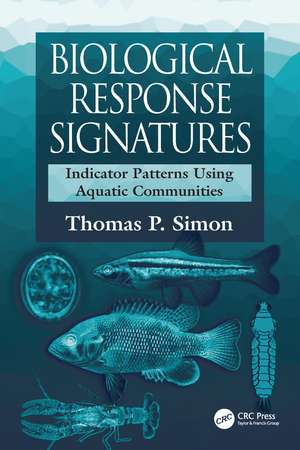Biological Response Signatures: Indicator Patterns Using Aquatic Communities
Editat de Thomas P. Simonen Limba Engleză Hardback – 17 iul 2002
The text uses state-of-the-art diagnostic tools to evaluate patterns in multimetric indices relating to known point or non-point source impacts. It describes the results of years of biological indicator development. It attempts to evaluate the differences in biological integrity between natural and altered landscapes. In addition, the book expands the types of organism indicator groups that are being used for assessments to include diatoms, aquatic macrophytes, aquatic invertebrates, mussels, fish, amphibians, and birds.
Contributors are among the top researchers and environmental biologists in North America and each provides their own perspective on current aspects of biological criteria implementation. The information contained in this text will appeal to a wide audience on the types of indicator chosen and the respective patterns among impacts discussed in the book. From the conceptual framework to the case studies, Biological Response Signatures will help readers better diagnose the stressors to biological communities and, thus, take actions to protect and restore water resources.
Preț: 1223.13 lei
Preț vechi: 1675.93 lei
-27% Nou
Puncte Express: 1835
Preț estimativ în valută:
234.04€ • 243.88$ • 193.79£
234.04€ • 243.88$ • 193.79£
Carte tipărită la comandă
Livrare economică 03-17 aprilie
Preluare comenzi: 021 569.72.76
Specificații
ISBN-13: 9780849309052
ISBN-10: 0849309050
Pagini: 600
Ilustrații: 166 b/w images
Dimensiuni: 178 x 254 x 37 mm
Greutate: 1.21 kg
Ediția:1
Editura: CRC Press
Colecția CRC Press
ISBN-10: 0849309050
Pagini: 600
Ilustrații: 166 b/w images
Dimensiuni: 178 x 254 x 37 mm
Greutate: 1.21 kg
Ediția:1
Editura: CRC Press
Colecția CRC Press
Public țintă
ProfessionalCuprins
Conceptual Framework. Contaminant Patterns in Ecosystems. Method Advancement. Land Use Modification Patterns and Effects of Non-Point Sources. Case Studies.
Descriere
This is the first book to examine the application of multimetric indices and biological indicators as endpoints to determine the relevancy of monitoring and evaluation programs. The text describes the results of years of biological indicator development and evaluates the differences in biological integrity between natural and altered landscapes. The contributors are among the top researchers and environmental biologists in North America and provide their own perspectives on current aspects of biological criteria implementation. The book helps readers better diagnose the stressors to biological communities, and thus take actions to protect and restore water resources.









